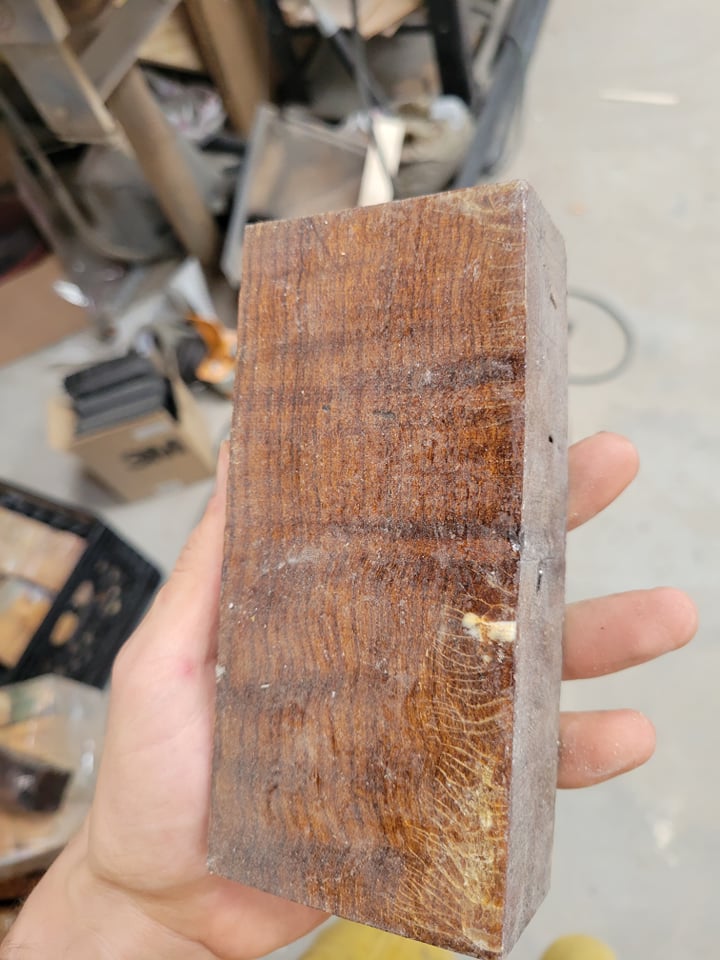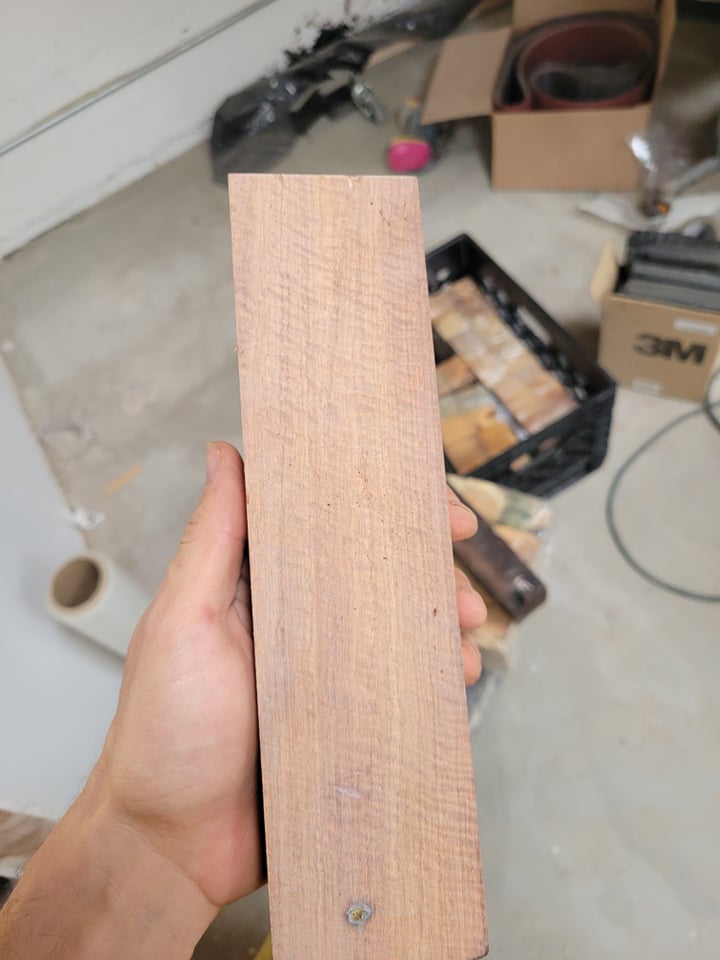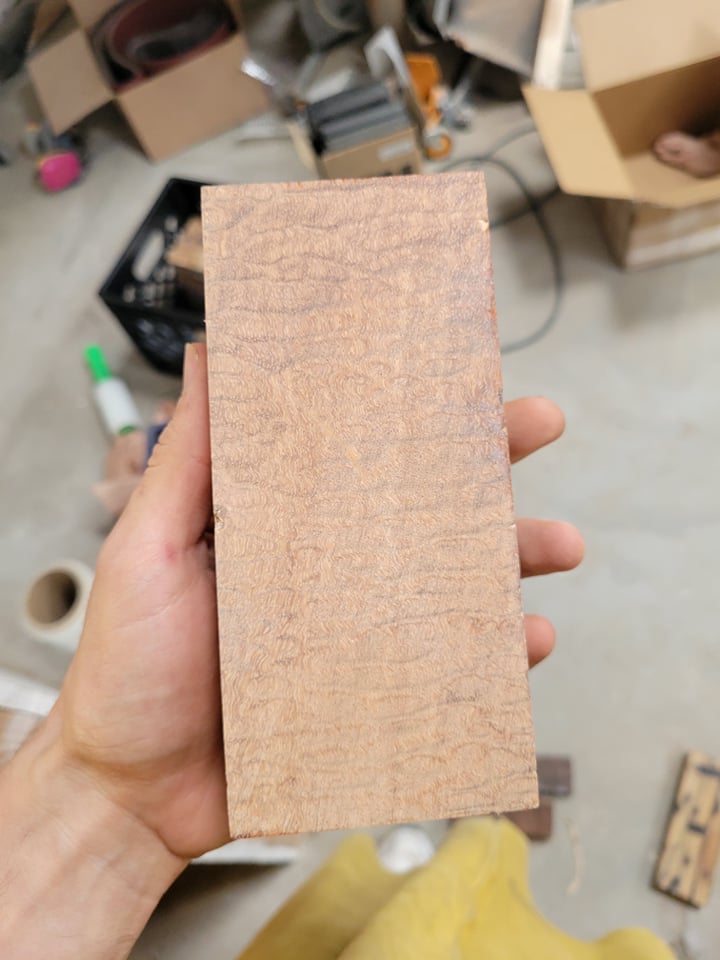Many people will ask me, what is stabilized wood? How do I know if a piece of wood is stabilized? Does this wood need to be stabilized? How do you stabilize wood? How much does it help?
These are all fair questions, as the process itself is relatively new, and not well-known outside of the knife-making field. So I will go step by step to answer the questions.
What is stabilized wood?
Stabilized wood is a type of composite material, but it is different from other composites you may know such as micarta or fiberglass. Stabilized wood is a timber that has had an acrylic polymer dissolved into a solvent, and then forced into the wood through a mix of vacuum and pressure cycles. The wood is then heated to drive off the solvent and cure the resin. This leaves a wood that is harder, denser, stronger, resistant to water, resistant to warpage, and will take a higher sheen than the natural wood. Stabilized wood is often the best choice for pieces that will be handled often, will be around water or large changes in humidity, and for highly figured or finished woods where the finish may become damaged or scuffed in time due to the relative softness of the material.
Knife makers are particularly fond of stabilized woods because even small amounts of natural wood movement can disrupt alignment, or cause scales to peel away from a tang, or open up very small gaps. It also allows many softer woods such as spalted maple and redwood burl to be used as handles. Naturally, these woods are far too soft and would gouge, scuff, and mark far too easily, but by stabilizing them these beautiful woods can be used for knife handles.
Below: stabilized woods after finishing


What is the thick and thin people talk about?
Professional stabilizers such as K&G use two different types of stabilizing resin depending on the density of the wood, called thick and thin solutions. A thick solution is used on less dense woods like buckeye burl, soft maple or redwood burl. It contains a higher concentration of resin and thus can add more weight. Thin solution is used on denser woods like Walnut, Koa, or Afzelia Xylay. Due to its lower concentration of resin, it is better able to penetrate and soak into these less porous woods.
How do I know if a piece of wood is stabilized?
I get this one a lot. I will say this. If you did not buy it from a knife maker, or knife supplier, it is almost certainly not stabilized. The process is rather expensive to be done, and is not common outside of these specific fields. Stabilized wood that has not been sanded will often be covered in hardened resin and will often be darker due to the heating used to cure the resin. This is not always the case though If it is from one of those sources, the easiest way to tell is to sand with a high grit belt. Stabilized woods will almost always produce a distinctly whiteish dust when sanded and a sweet smell regardless of the species of wood.
Below: Stabilized woods with hardened resin over them


Below: sanded stabilized wood showing the pale white finish stabilized wood has


Does my wood Need to be stabilized?
It depends. I sell a mix of natural and stabilized wood. Whether or not I sell a wood as natural or stabilized is a choice I make based on my over 10 years of rare wood experience. Some woods benefit greatly from stabilizing, some have a minor gain, others have little to no gain. Some woods are particularly oily and resist stabilizing. I have a list of my recommended woods here Wood Identification and info. If you cant find info about it, you can feel free to fill out a contact form, I'm always happy to help. This page has some of my recommendations for what woods can/ should be stabilized, Wood Identification and info
How do you stabilize wood?
This is always a big one. My answer has always been, I don't. I pay experts to do it professionally. All the stabilizing I have done is done by the good people at K&G, they are the industry leaders in the process, and in all my years no one has come close to matching their quality. There are many people looking to stabilize at home, or buy home stabilized products. I say best of luck, but in my experience no one has beaten the pros. What is quality in stabilizing? Weight gain, penetration, and finish finishing. In my 10 years of working with stabilized woods, I have not found a home stabilizing setup that can beat both the quality and consistency of wood stabilized by K&G.
They're website can be found here https://knifeandgun.com/collections/custom-stabilizing
How much does it help?
There is no single answer. It varies by both species and individual block. Wood is a natural product, and in many ways a product of its environment. Plantation grown wood that was not exposed to high stresses will be lighter and less dense than woods growing in poor soil, exposed to heavy winds and other stresses. I will try to give some rough guides.
In general, very light wood like buckeye burl, light maple burl, Redwood burl, Cottonwood and poplar will roughly double or triple in weight when properly stabilized. They will go from soft and almost foam like to slightly harder than a wood like natural rock maple, resistant to most regular scuffing but still not as hard as exotics.
Medium density woods like Hard maple, koa, Amboyna, Walnut and bog oak will gain roughly 60%-80% weight, and will become roughly as durable as exotic woods like blackwood or cocobolo.
Dense woods like ebony, rosewood, and Ironwood benefit minimally, if at all from stabilizing. Woods like Ebony or bubinga can become more stable and resistant to cracking due to humidity changes, but in my experience the advantages are relatively minor and the choices should be made on a person basis.
I sent wood to be stabilized/ tried to stabilize my own and it cracked badly! What happened?
It was wet. All the wood in the world starts off wet, and drying wood is a slow, painstaking an difficult process, especially for figured or burl woods. Many sellers will call woods fully dried, but they simply are not. I will always be honest, and if I am unsure about a the moisture of a wood I will always make a note of it. Dry woods slowly and carefully, there is no super fast and fully safe way to dry woods without cracks. Go slow.
Part of the reason for the cost of my woods is the extreme care i take in drying every piece perfectly. Moving, wrapping, waxing, checking with a moisture meter to prevent the build up of stresses that will at some point cause cracks and checks. Its a slow process, and often sellers will hide it and let the wood crack once it is in the possession of the buyer. I work hard to dry wood without stresses or issues so the products I sell will last as long as possible.
What stabilizing does NOT do.
Stabilizing will not fill voids or gaps. Stabilizing resin will fill wood, it will not fill gaps. For large gaps or voids, use epoxy with black dye, and for small gaps use CA glue.
Stabilizing also does not make wood plastic. Well stabilized wood still looks like and works like wood. It still has a grain structure and can be worked with chisels, saws and abrasives. It simply strengths and enhances the wood.
After finish sanding, multiple layers of a standard finishing oil or wax can be applied to enhance the appearance and protect the finish.
It is important to know that not all woods can be stabilized. Woods that are very high in oil like myrtle, some cedars, camphor and others do not stabilize well, they have low weight gain and may not set properly. As a general rule, if I feel a wood should be stabilized, I will have it stabilized.
